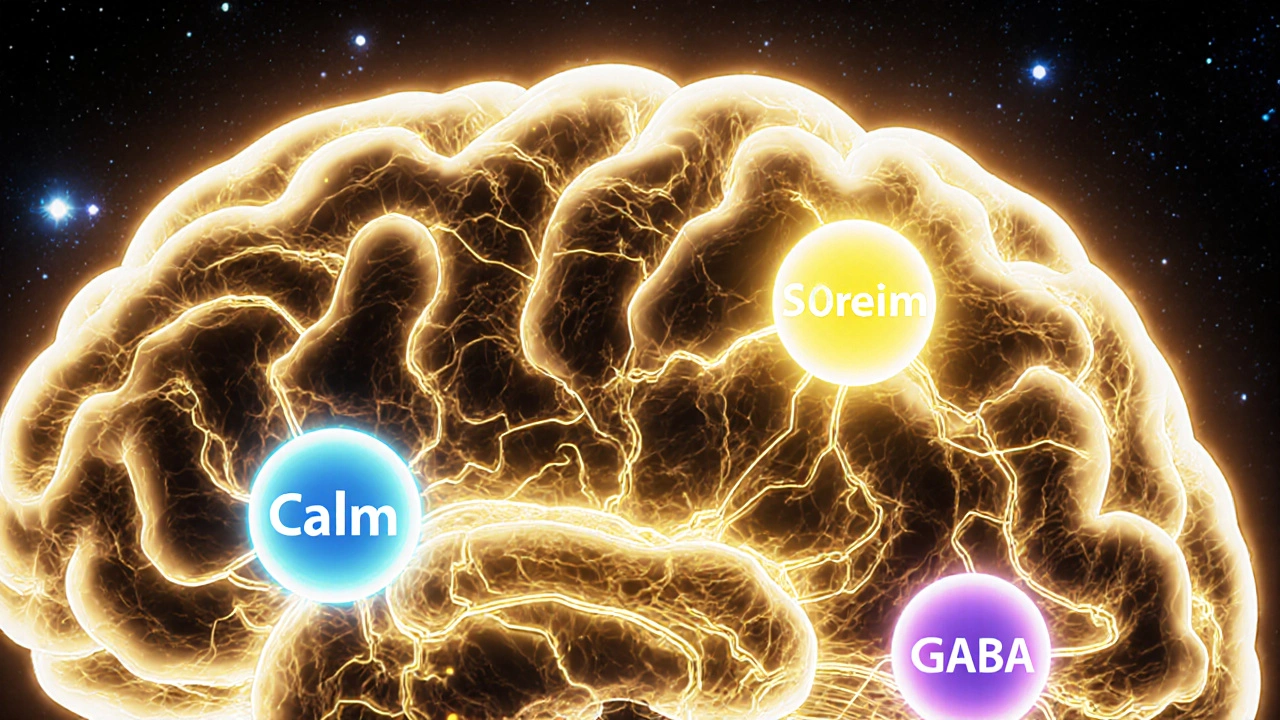Your nervous system is running nonstop-processing thoughts, controlling your heartbeat, sending signals to your muscles, and reacting to every sound, touch, and smell around you. But what keeps all those signals firing smoothly? One key player is pyridoxine, better known as vitamin B6. It’s not flashy like vitamin C or trendy like vitamin D, but without it, your brain and nerves wouldn’t work right.
What Pyridoxine Actually Does in Your Nerves
Pyridoxine isn’t just a supplement you take when you feel tired. It’s a coenzyme-meaning it teams up with proteins to make chemical reactions happen. In your nervous system, it helps build neurotransmitters like serotonin, dopamine, and GABA. These are the brain’s messaging chemicals. Serotonin affects your mood. Dopamine drives motivation and focus. GABA calms overactive nerves. Without enough pyridoxine, your body can’t make these in sufficient amounts.
Think of it like a factory line. Pyridoxine is the wrench that turns the bolts holding the machinery together. No wrench, no assembly. No pyridoxine, no balanced neurotransmitters. That’s why low levels are linked to anxiety, depression, and even sleep problems. A 2023 study in the Journal of Clinical Neurology found that people with chronic nerve pain and low B6 levels saw measurable improvement after just six weeks of supplementation.
How Your Body Uses Pyridoxine Daily
Your body doesn’t store pyridoxine well. You need about 1.3 to 1.7 milligrams a day, depending on your age and sex. That’s not much-but it’s essential. Every time your nerve cells send a signal, they use up some of this vitamin. It’s constantly being recycled, but you still need to replace it through food or supplements.
Pyridoxine helps convert homocysteine, a harmful amino acid, into less dangerous compounds. High homocysteine levels are tied to nerve damage and inflammation. By keeping homocysteine in check, pyridoxine protects your nerves from slow, silent harm. It also helps maintain the myelin sheath-the fatty coating around nerve fibers that speeds up signal transmission. Think of myelin as the insulation on an electrical wire. If it breaks down, signals sputter or short-circuit.
Signs You Might Be Low in Pyridoxine
Severe B6 deficiency is rare in healthy adults, but mild shortages are more common than you think. You might not realize you’re affected until symptoms show up. Common signs include:
- Chronic tingling or numbness in hands and feet
- Increased irritability or unexplained mood swings
- Difficulty sleeping or frequent nightmares
- Weakness or muscle fatigue without obvious cause
- Worsening of PMS symptoms, especially in women
People at higher risk include those with kidney disease, autoimmune disorders like rheumatoid arthritis, heavy alcohol users, and older adults with poor diets. Even some common medications-like birth control pills, metformin for diabetes, and certain antibiotics-can lower pyridoxine levels over time.

Food Sources That Actually Deliver Pyridoxine
You don’t need pills to get enough pyridoxine. Real food works better because it comes with other nutrients that help your body use it. The best sources include:
- Chickpeas (1 cup cooked = 1.1 mg)
- Salmon (3 oz cooked = 0.6 mg)
- Chicken breast (3 oz cooked = 0.5 mg)
- Potatoes (1 medium with skin = 0.4 mg)
- Bananas (1 medium = 0.4 mg)
- Fortified cereals (check labels-some offer 100% of daily value per serving)
One cup of chickpeas gives you nearly your entire daily need. That’s why Mediterranean and Middle Eastern diets, rich in legumes and whole grains, often support strong nervous system function. Cooking doesn’t destroy pyridoxine much, but boiling vegetables in lots of water can leach it out. Steaming or roasting is better.
Pyridoxine vs. Other B Vitamins
People often confuse B6 with B12 or folate. They all work together, but they do different jobs. B12 protects nerve cells and makes red blood cells. Folate helps with DNA repair and cell division. Pyridoxine is the one that actually builds the brain chemicals. You can have perfect B12 levels and still be low in B6-and still feel off.
That’s why some supplements combine B6 with B12 and folate. It’s called the B-complex. For nerve health, this trio is powerful. A 2022 trial from the University of California found that people taking a daily B-complex supplement reported better focus, less brain fog, and improved nerve sensation within eight weeks.

When to Consider a Supplement
If you eat a balanced diet with plenty of legumes, fish, and whole grains, you probably don’t need a supplement. But if you’re dealing with nerve pain, persistent anxiety, or trouble sleeping-and your doctor rules out other causes-testing your B6 levels makes sense. Blood tests for pyridoxine are not routine, but they’re available.
Most over-the-counter B6 supplements contain 10 to 50 mg. That’s far more than you need daily. Long-term use of doses above 100 mg can actually cause nerve damage. Too much isn’t better. Stick to 10-25 mg if you’re supplementing, and only if advised by a healthcare provider.
What Happens When You Get It Right
When your pyridoxine levels are balanced, your nervous system runs quietly and efficiently. You sleep deeper. You handle stress better. You don’t get sudden mood crashes. Your fingers don’t go numb when you type for too long. You feel more present, less wired, and less drained.
It’s not magic. It’s biochemistry. Pyridoxine doesn’t cure diseases. But it supports the foundation your nervous system is built on. And when that foundation is strong, your whole body benefits.
Start with food. Eat chickpeas. Eat salmon. Eat a banana with your morning oatmeal. If you’re still feeling off after a few weeks, talk to your doctor. Don’t guess. Don’t megadose. Just make sure your body has what it needs to keep your nerves firing the way they should.
Can pyridoxine help with anxiety?
Yes, pyridoxine can help with anxiety because it’s needed to make serotonin and GABA-two brain chemicals that calm the nervous system. Low levels of B6 are linked to higher anxiety in multiple studies. Supplementing with B6, especially when deficient, can reduce symptoms, but it’s not a replacement for therapy or medication in severe cases.
How long does it take for pyridoxine to work on nerves?
If you’re deficient, you may notice improvements in nerve tingling, sleep, or mood within 2 to 4 weeks of consistent intake. For chronic nerve issues, it can take up to 8 weeks to see full benefits, especially when combined with other B vitamins. The body needs time to rebuild neurotransmitter levels and repair nerve signaling.
Can too much pyridoxine hurt your nerves?
Yes. Taking more than 100 mg of pyridoxine daily for months can cause sensory neuropathy-numbness, burning, or loss of balance. This is rare and usually only happens with high-dose supplements, not food. The safe upper limit is 100 mg per day for adults. Stick to 10-25 mg unless a doctor recommends more.
Is pyridoxine the same as vitamin B6?
Yes. Pyridoxine is the most common form of vitamin B6 found in food and supplements. Other forms include pyridoxal and pyridoxamine, which your body converts into the active form. When you see "vitamin B6" on a label, it usually means pyridoxine unless otherwise specified.
Does pyridoxine help with carpal tunnel?
Some people with mild carpal tunnel report reduced numbness and tingling after taking B6 supplements. Research is mixed, but one 2021 study showed that 60% of participants with early-stage carpal tunnel improved after 6 weeks of 100 mg B6 daily. However, it’s not a cure. If symptoms persist, see a specialist-B6 may help support nerve function, but it won’t fix physical compression.

Ted Carr
November 2, 2025 AT 11:07So let me get this straight-we’re now treating vitamins like they’re the secret sauce to modern life? Next they’ll say sunlight is just a placebo for vitamin D.
Rebecca Parkos
November 4, 2025 AT 06:42I was suffering from chronic tingling in my hands for months-doctors kept saying it was stress. Then I started eating chickpeas daily and took a 25mg B6 supplement. Within three weeks, the numbness was gone. This isn’t magic-it’s biology. Why do people ignore basic biochemistry until it’s too late?
Bradley Mulliner
November 5, 2025 AT 07:59Of course the article ignores the pharmaceutical industry’s role in suppressing natural remedies. B6 has been used for decades in alternative medicine to treat neurological disorders. But mainstream medicine won’t acknowledge it unless it’s patented and profitable. They’d rather sell you SSRIs than let you eat a banana.
Rahul hossain
November 7, 2025 AT 05:20In my village in Bihar, grandmothers have always boiled chickpeas with turmeric and fed them to nervous children. No pills. No labs. Just food. Now science finally catches up-two centuries late. We knew this before your ‘clinical trials’ were even conceived. Still, I’m glad someone wrote it down in English so the West might listen.
Reginald Maarten
November 8, 2025 AT 21:51Technically, pyridoxine is one of several vitamers of vitamin B6. The active coenzyme form is pyridoxal phosphate (PLP). Most supplements contain pyridoxine HCl, which must be converted by the liver-this conversion is inefficient in up to 30% of the population due to genetic polymorphisms in ALDH7A1. So claiming B6 supplements ‘work’ is misleading without context. Also, the 2023 study cited? It had a sample size of 42. Underpowered. And the 2022 UC trial? Double-blind, yes-but placebo group received maltodextrin, not a nutrient-depleted control. Methodologically sloppy.
Jonathan Debo
November 8, 2025 AT 23:30STOP. JUST STOP. You can’t just say ‘eat chickpeas’ and expect that to fix complex neurological dysfunction. Have you read the biochemistry? Have you considered the blood-brain barrier permeability of PLP? Or the fact that B6 deficiency is rarely isolated-it’s almost always tied to B12 or folate deficiencies? And why are you recommending 10–25 mg? That’s still 15x the RDA! You’re normalizing megadosing under the guise of ‘caution’! This is dangerous pseudoscience dressed as nutrition advice!!!
Robin Annison
November 10, 2025 AT 08:58It’s funny how we treat the nervous system like a machine that needs tuning, when it’s more like a living ecosystem. Pyridoxine isn’t a fix-it’s a gentle nudge. The real question isn’t whether you need more B6… it’s why your life has become so depleted that your nerves are screaming for it. Maybe the banana isn’t the answer. Maybe the silence, the screen time, the rush, the loneliness… those are the real deficiencies.
Albert Schueller
November 11, 2025 AT 04:42Wait… so if B6 helps with anxiety… then why did the CDC say it’s linked to mass shootings? I read it on a forum. They said the government adds it to water to make people docile. But then they take it out of the water when they want us to riot. It’s a psyop. I took 100mg for a week. My dreams got weirder. That’s not coincidence. That’s mind control.